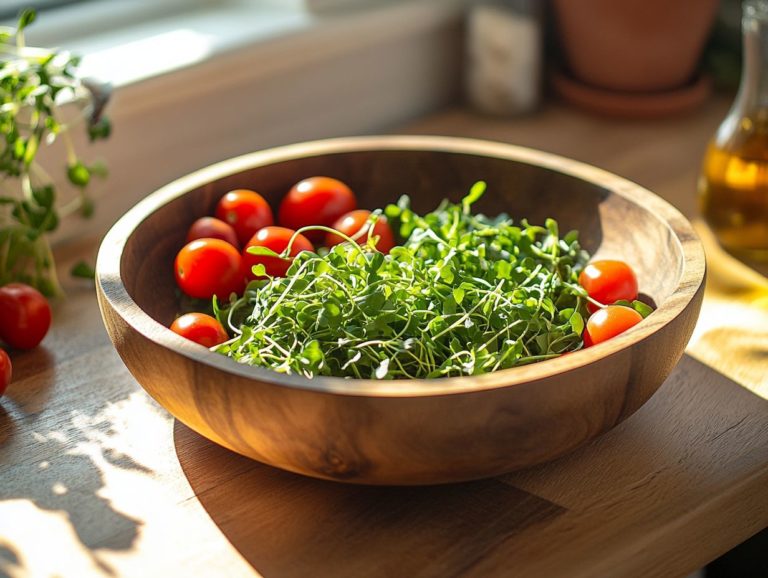10. Best Microgreens for Soups and Stews
Microgreens are petite, nutrient-dense seedlings that possess the remarkable ability to elevate your soups and stews into culinary masterpieces.
These vibrant greens do more than just add a pop of flavor; they also enhance the nutritional value of your meals, providing a variety of microgreens that are easy to grow and high in vitamins.
Dive into the world of top microgreens that are perfect for enriching your favorite cozy dishes, complete with insightful tips on seamlessly incorporating them into your recipes.
Uncover the health benefits, such as their high vitamin content, that make these tiny greens an essential addition to your kitchen arsenal!
Contents
- Key Takeaways:
- Top Microgreens for Soups and Stews
- Tips for Using Microgreens in Soups and Stews
- Health Benefits of Microgreens in Soups and Stews
- Frequently Asked Questions
- Which microgreens are best for adding to soups and stews?
- Why are microgreens a great addition to soups and stews?
- Can you use any type of microgreens in soups and stews?
- How should I prepare microgreens before adding them to my soup or stew?
- Are there any microgreens to avoid in soups and stews?
- Can I use microgreens in homemade or store-bought soups and stews?
Key Takeaways:
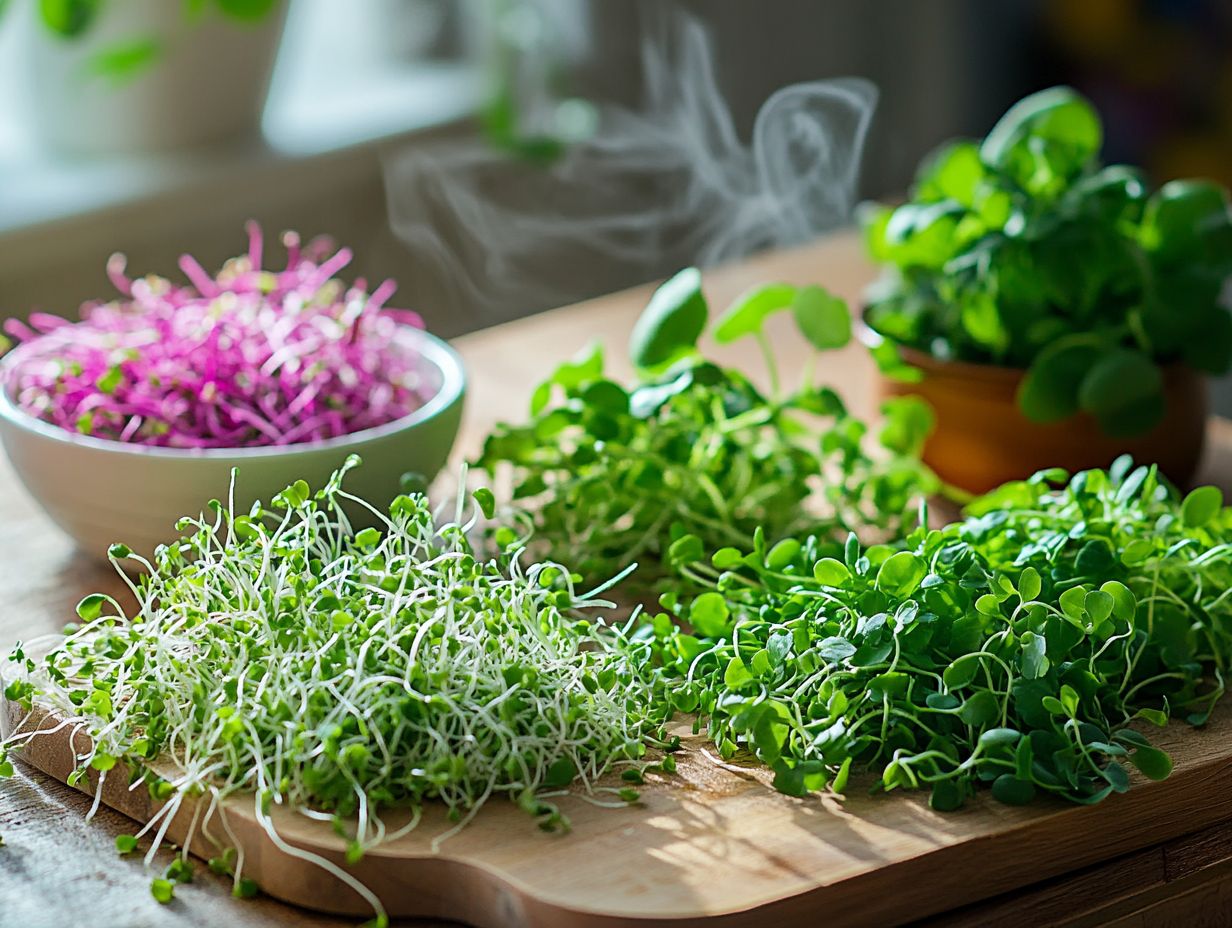
- Add flavor and nutrition to your salads and soups with microgreens.
- For spice and crunch, radish or mustard microgreens make excellent salad toppings.
- Incorporate nutrient-rich microgreens like kale, spinach, and carrot to boost health benefits.
What are Microgreens and Why Use Them in Soups and Stews?
Microgreens are young plants harvested shortly after germination. They pack a punch of flavor and nutrients, making them a perfect addition to your soups and stews, including heirloom varieties like red cabbage.
These miniature greens act as nutritional powerhouses, often containing concentrations of vitamins, minerals, and antioxidants that far outshine their mature counterparts. Take arugula microgreens, for example; its peppery bite not only elevates your dishes but also brings an abundance of vitamins A, C, and K to the table, making it a favorite for home gardening.
On the other hand, broccoli microgreens introduce a subtly sweet flavor while boasting high levels of sulforaphane a compound that may help improve health along with iron and manganese, recognized for their potential health benefits.
Adding these microgreens enhances flavors and enriches the nutritional value of your meals. Each bowl transforms from mere comfort food into a powerhouse of health goodness, thanks to the variety of microgreens that provide easy-to-grow options for any kitchen.
Top Microgreens for Soups and Stews
In the realm of crafting exquisite soups and stews, selecting the finest microgreens can elevate both the flavor and nutritional value of your creations, including unique varieties like kohlrabi microgreens.
These petite greens, featuring an enticing selection like broccoli, radish, pea microgreens, and the unique flavor profile of sunflower microgreens, offer an impressive burst of taste and health advantages.
Their distinct flavor profiles harmoniously enhance a multitude of recipes, transforming them into essential components of your healthy culinary repertoire, making them a great choice for recipes and home gardening alike.
1. Broccoli Microgreens
Broccoli microgreens are not just packed with nutrients; they also bring a delightful crunch and a hint of peppery flavor to your soups and stews, enhancing the overall flavor profile.
These tiny greens are a powerhouse of vitamins and minerals, particularly rich in vitamin K and iron, both of which support bone health and enhance circulation.
By incorporating broccoli microgreens into your recipes, such as creamy potato soup or hearty vegetable stew, you can elevate the nutritional value of your dish while introducing a fresh taste, along with a variety of best microgreen varieties for beginners for added depth. You can simply sprinkle them on top as a vibrant garnish or blend them into the recipe for added depth.
Their versatility ensures they fit seamlessly into a variety of dishes, making healthy eating both enjoyable and flavorful, perfect for those exploring home gardening.
Don’t miss out on these delicious and healthy microgreens! Start your microgreens journey today!
2. Radish Microgreens
Radish microgreens offer a spicy kick and a burst of color. They make an exceptional addition to any soup or stew, enhancing the flavor profile of your dishes. Their distinctive taste, marked by a zesty crunch and a peppery undertone, elevates the flavors while also enhancing the visual appeal of your meals. They are perfect as salad toppings.
You ll love how versatile these tiny greens can be! Add them to salads, sandwiches, and tacos for a delicious twist, especially when mixed with carrot microgreens. For example, incorporating radish microgreens into a simple avocado toast transforms it into a gourmet delight. Their presence in a classic coleslaw introduces an unexpected and delightful twist.
These microgreens are loaded with vitamins A, C, and K and essential minerals like iron and calcium, making them a true healthy choice for any meal!
3. Pea Shoot Microgreens
Pea shoot microgreens add a sweet and tender touch to your soups and stews. They enhance both texture and taste in a delightful way, making them a favorite among healthy eating advocates.
These charming greens taste incredible and are a nutritious choice. They are rich in vitamins A, C, and K, along with essential minerals like iron and calcium. Their delicate, slightly nutty flavor elevates your salads and sandwiches, making them a versatile addition to various culinary creations. When saut ed gently or used as a garnish, they retain their crispness while providing a vibrant splash of color.
For an exceptional dish, try incorporating them into a spring vegetable risotto or blending them into a fresh pesto to drizzle over grilled meats or roasted vegetables!
4. Cilantro Microgreens
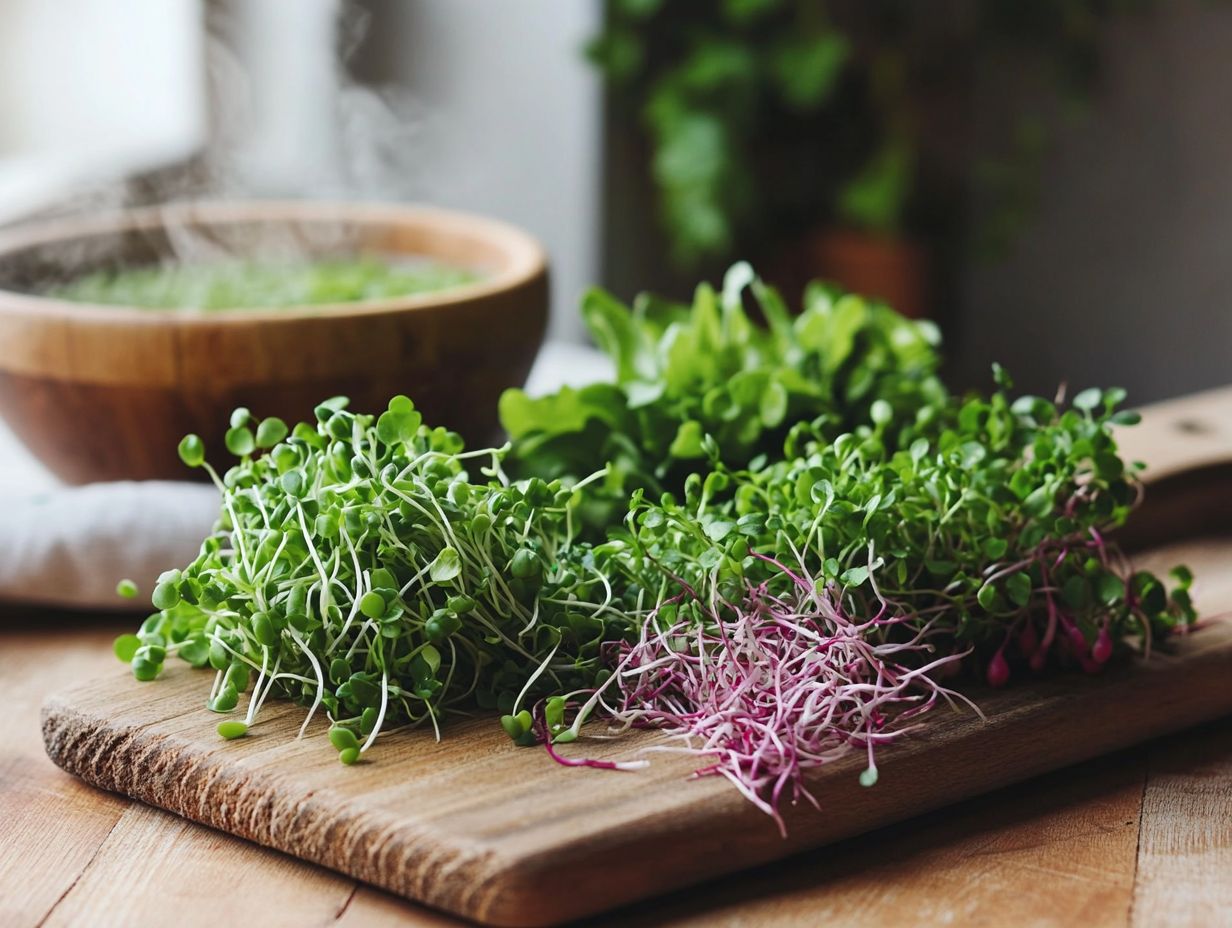
Cilantro microgreens are a flavorful herb that can transform your soups and stews. Their fresh, citrusy notes add a delightful twist to any recipe.
These tiny greens deliver an aromatic burst and pack essential nutrients like vitamins A, C, and K. They are a nutritious addition to any dish, especially for home gardening enthusiasts. The bright, zesty flavor of cilantro microgreens pairs beautifully with grilled meats, providing a refreshing contrast that elevates even the simplest recipes.
If you’re feeling adventurous, incorporate them into vibrant salsas, sprinkle them atop tacos, or blend them into smoothies for a delightful herbal kick. Their antioxidant properties may help protect your cells and support overall health, making them an excellent choice for culinary enthusiasts who value flavor and wellness!
5. Kale Microgreens
Kale microgreens, often hailed as a superfood, elevate not just the nutritional profile but also the flavor of your soups and stews. They bring mild, earthy notes, making them a staple for home gardening.
These petite greens are rich in essential vitamins A, C, E, and K providing a remarkable boost to overall health. Packed with antioxidants, they help combat oxidative stress, and their impressive fiber content supports digestive health. Kale microgreens are a beneficial choice for healthy eating.
Incorporating kale microgreens into your meals is easy! Sprinkle them atop salads for added crunch, or blend them into smoothies for a revitalizing nutrient boost. They also serve as a delightful garnish for sandwiches and wraps, enhancing both flavor and nutritional impact. You will enjoy all the benefits these tiny powerhouses offer!
Try growing these microgreens at home and experiment with delicious recipes today!
6. Arugula Microgreens
Arugula microgreens offer a distinct peppery flavor that elevates the taste profile of your soups and stews. They make an exceptional addition to any recipe.
These tiny greens are incredibly versatile, perfect for salads and even as toppings.
When you sprinkle them atop salads, arugula microgreens deliver a fresh burst of taste and texture, perfectly complemented by both creamy and vinaigrette dressings, boosting the flavor. Their nutritional benefits are impressive. They’re packed with vitamins A, C, and K, rich in antioxidants, making them a superfood addition to any meal, especially when used in recipes for healthy eating.
Incorporating these microgreens into your omelets or grain bowls can truly elevate your dishes while enhancing their nutritional value. They’re a favorite among health-conscious food enthusiasts, particularly those exploring home gardening methods.
7. Mustard Microgreens
Mustard microgreens bring a zesty flair to your dishes, transforming everyday meals into culinary delights, especially in soups and stews where their flavor can shine.
These tender greens not only enhance flavor but also deliver an impressive nutritional boost, rich in vitamins A, C, and K, along with essential minerals like calcium and iron. Their bold, peppery taste can elevate even the simplest salad or sandwich, injecting an unexpected zing that tantalizes the taste buds and enhances the flavor.
Mix them into a classic egg salad for a quick and tasty option, or explore other recipes that highlight their unique flavors. Toss them into a stir-fry to add an extra dimension of flavor, or use them as a vibrant garnish atop grilled meats or roasted vegetables, enhancing their nutritional benefits.
The versatility of mustard microgreens makes them a beloved choice among both chefs and home cooks. Ensure that your culinary creations are anything but ordinary, especially when paired with other microgreens for added flavor.
8. Spinach Microgreens
Spinach microgreens are your secret weapon in the kitchen, delivering a wealth of vitamins while adding a subtly delightful flavor to soups and stews, contributing to a healthy eating experience.
These petite greens are packed with vitamins A, C, and K, providing a health boost that s hard to overlook, especially in the context of home gardening.
Their tender leaves not only elevate the taste of your dishes but also supply antioxidants that support your overall well-being, making spinach microgreens a versatile choice in many recipes.
Incorporating them into your meals is a breeze; sprinkle them over salads, blend them into smoothies, or use them as a fragrant garnish for omelets or sandwiches, enhancing their nutritional impact with these healthy greens. Spinach microgreens are a must-have in any kitchen!
9. Basil Microgreens
Basil microgreens not only bring a delightful aroma to your kitchen but also elevate the flavor of your soups and stews with their unique herbal notes.
These tiny greens pack a flavorful punch, adding vibrancy to your dishes and making them a favorite among both seasoned chefs and home cooks. Their slightly peppery flavor profile complements a variety of cuisines, shining in pesto sauces and pasta dishes while delivering a refreshing kick in salads. For those looking to elevate their cooking, exploring the top microgreen varieties for gourmet cooking is a must.
When you add basil microgreens to your sandwiches and wraps, simple meals transform into culinary delights. Their visual appeal adds a touch of elegance to your plated entrees, inviting diners to savor a burst of flavor that captures the essence of fresh herbs.
Whether you sprinkle them on top or blend them into sauces, these microgreens play a crucial role in enhancing your overall dining experience.
Experiment with these top 5 microgreens for smoothies today and enjoy a burst of flavor and nutrition in every bite!
10. Chives Microgreens
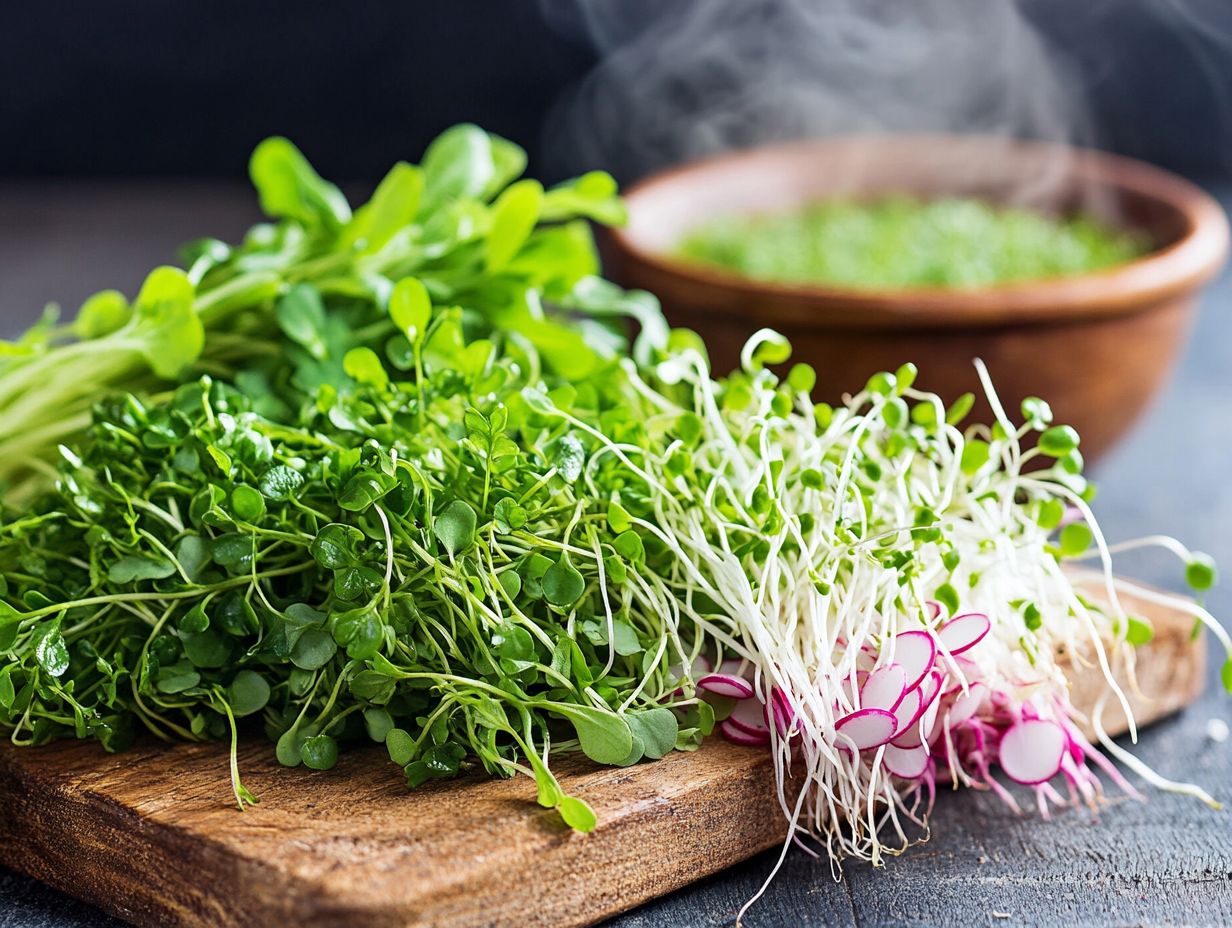
Get ready to elevate your soups and stews to a whole new level with chives microgreens! Chives microgreens bring a delightful mild onion flavor to the table, making them an exceptional garnish a way to make food look and taste better for your soups and stews.
These delicate greens have the power to enhance not just savory meals but also salads and spreads. They infuse a subtle yet distinctive taste that beautifully complements a range of ingredients. Their vibrant green hue enhances the visual allure of any plate, beckoning diners to indulge in what lies before them.
Packed with vitamins A, C, and K, they provide a nourishing boost while keeping calorie counts delightfully low. This remarkable versatility allows you to unleash your creativity whether you re whipping up omelets, topping baked potatoes, or blending them into dressing.
Chives microgreens are truly a must-have for anyone eager to enhance both flavor and nutrition in their culinary creations.
Tips for Using Microgreens in Soups and Stews
Incorporating microgreens into your soups and stews can elevate both their flavor profile and nutritional value. Understanding how to do this effectively is essential for unlocking the full benefits they offer.
How to Incorporate Microgreens into Your Recipes
Incorporating microgreens into your recipes is not only simple but also a game changer for elevating the flavor and nutritional profile of your soups and stews.
These vibrant little plants don’t just bring a splash of color to your dishes; they also deliver a powerful punch of vitamins and minerals. Imagine topping a hearty potato leek soup with a sprinkle of radish microgreens; suddenly, you have a delightful peppery bite that enhances the overall taste. For a deeper dive into the nutritional benefits, check out the best microgreens for nutritional value.
Mixing basil microgreens into a classic marinara sauce infuses it with a fresh, aromatic quality that beautifully complements your pasta creations. Don’t overlook the magic of tossing a handful of sunflower microgreens into a refreshing salad; they add a crunchy texture that transforms everyday meals into something exciting and nutritious. For more inspiration, explore must-try microgreen varieties for salads.
Health Benefits of Microgreens in Soups and Stews
Incorporating microgreens into your soups and stews offers a wealth of health benefits. These tiny greens are packed with nutrients, making them an excellent addition to your meals and a valuable component of a balanced diet.
- Microgreens are a treasure trove of vital nutrients, boasting vitamins A, C, E, and K, along with essential minerals.
- They deliver a wealth of antioxidants that are instrumental in reducing inflammation and safeguarding your cells from damage.
- For example, kale microgreens are renowned for their impressive vitamin K content, which supports bone health.
- Meanwhile, radish microgreens pack a zesty punch of vitamin C, giving your immune system a well-deserved boost.
- By incorporating a diverse array of these nutrient-rich plants into your daily meals, you can significantly enhance your nutritional intake.
- They make a delightful addition to salads, smoothies, or as eye-catching garnishes on a variety of dishes.
Frequently Asked Questions
Here are some common questions about using microgreens in your soups and stews:
Which microgreens are best for adding to soups and stews?
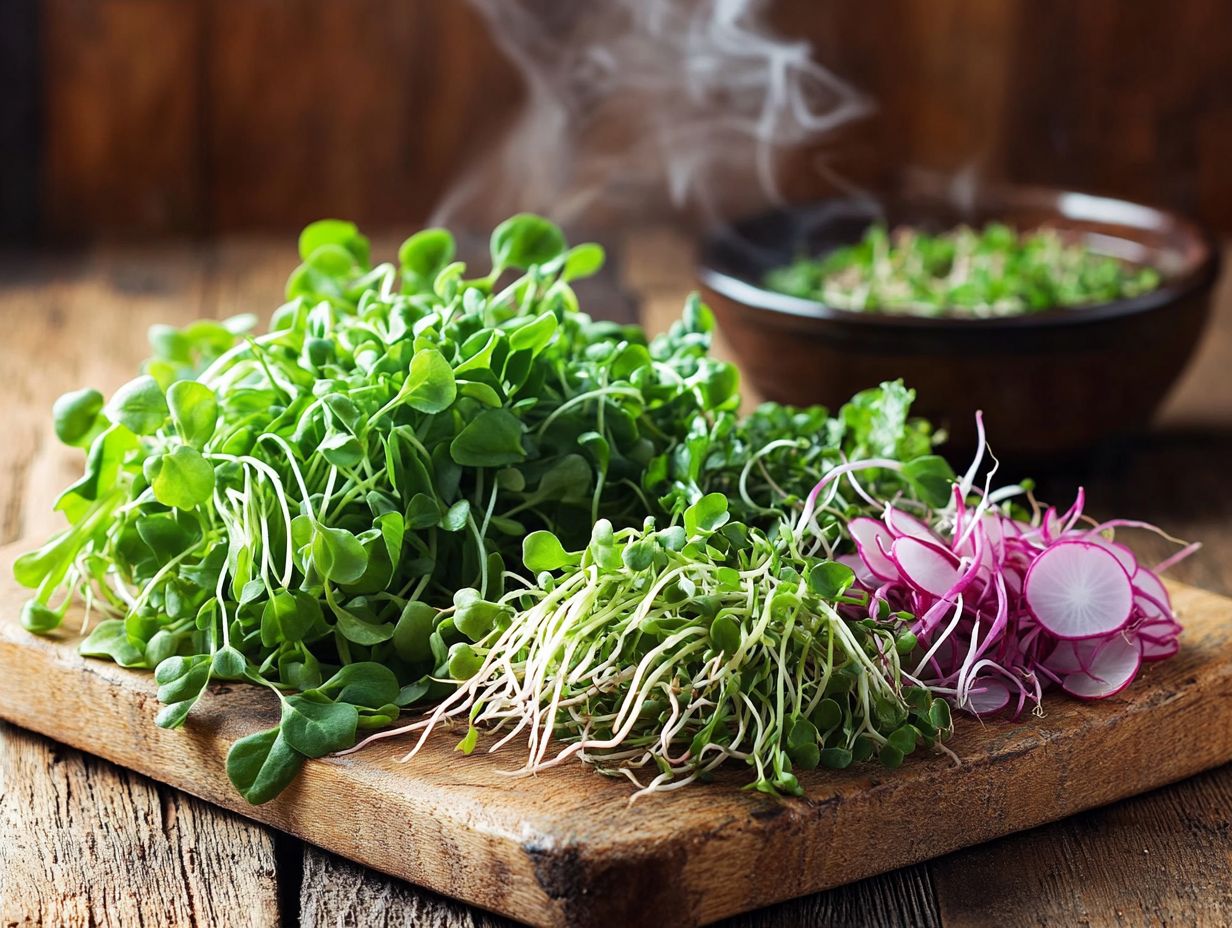
Some of the best microgreens to add to soups and stews are broccoli, radish, kale, mustard, and pea shoots.
Why are microgreens a great addition to soups and stews?
Microgreens not only add flavor to soups and stews, but they also provide a nutritional boost due to their high concentrations of vitamins, minerals, and antioxidants.
Can you use any type of microgreens in soups and stews?
While any type of microgreens can technically be used, certain varieties hold up better in hot soups and stews. It is best to stick with heartier greens like kale, broccoli, and radish for best results.
How should I prepare microgreens before adding them to my soup or stew?
Microgreens should be gently washed and dried before adding them to soups and stews. You can also trim any long stems or roots to fit better into the dish.
Don t miss out on these delicious and nutritious greens! Start incorporating microgreens into your meals today!
Are there any microgreens to avoid in soups and stews?
Avoid using fragile greens like cilantro, basil, and parsley in soups and stews.
They wilt quickly and lose flavor in hot liquids.
Can I use microgreens in homemade or store-bought soups and stews?
Yes!
Microgreens are a versatile addition to any soup or stew, whether homemade or store-bought.
Just keep an eye on the recommended serving sizes for your dish!






